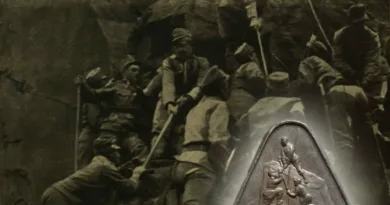The Danube Flotilla and SMS Temes at the Serbian border
The Monarchy built a fleet of monitor-type ships in the years before the Great War. One of these ships was SMS Temes, built in 1904. Its two turrets were located on two sides of the ship’s first third. These were fitted with two 12 cm rapid-fire cannons. The ship’s armament included a 12 cm howitzer placed in the middle near the stern. The three cannons were supplemented by machine guns.
The first deployment of the flotilla’s units, including Temes, took place on the first day of the Great War, at dawn on July 29, when Belgrade was shot. After that, the three ships deployed in Zimony, Temes, Bodrog and Szamos, took part in missions against Serbia on the Sava River and the Danube. Their main task was to prevent Serbian river crossings. This task was generally successfully completed, including an attempt near Zimony on September 29th. Serbian river crossing on the Sava took place only when, due to the low water level, ships were unable to reach the affected section of the river. The commander of the Danube Flotilla, Lieutenant Olaf Wulff, received the Knight’s Cross of the Military Order of Maria Theresia for the successful attack on September 29.

In October, Serbian troops mined the Sava River. On the evening of October 22, Temes was on duty in the vicinity of Szabács. On the way home, the ship ran into a mine at the height of Klenak village. In the explosion and then in enemy rifle fire from the shore, 31 sailors died. The rescue was carried out by a gunboat accompanying the Temes. The higher parts of the hull of the sunken ship protruded from the water.
After the fall of Serbia in 1916, the hull of Temes was recovered from the Sava. The ship was towed to Budapest with the help of barges and a tugboat. The damage assessment described severe damage to the hull, but the engine and boilers could be restored. Thus, the command of the Monarchy decided to repair the ship. The injured middle part was cut out, replaced by a new middle part divided into four ribs three meters longer. The location of the parts of the superstructure, the bridge and the gun towers, was also changed. Instead of the howitzer, a 9 cm dual-use cannon placed in two turrets was built in front of the stern. The refurbished monitor was launched on January 18, 1917, in a ceremonial setting, in the presence of the monarch. After test drives on the Sava and Danube near the sinking point, the ship was put back into service on 25 June. His new station became Braila after the defeat of Romania.

Temes patrolled the Danube in 1917 and 1918. She did not participate in the contingent directed to Ukraine, which ran mainly on the Dnieper River and was stationed in Odessa. More significant deployments took place in the final phase of the war, in October, when it had to secure the crossings of the retreating Allied troops on the Danube. By this time he had already received fire from the advancing French troops from the occupied southern bank of the Danube. On October 28, the Danube Flotilla retreated to Újvidék. On November 6, it marched to Budapest, except for Bodrog, which ran aground and stayed on the way. Temes was handed over by the Hungarian government to the representatives of the war-winning entente on December 13, 1918. The ship was later allocated to Romania.
The model of SMS Temes is exhibited in the Vienna Military Museum. The badge was prepared by ARKANZAS. The ship’s image is rather symbolic on the badge.




